Perfectly poached eggs in silicone cups make the frightening task of poaching eggs simple and foolproof. You will have the ideal form, with soft whites and yolks precisely the way you like them.How to use silicone egg poacher?
Poaching eggs can be difficult, but using silicone cups eliminates the mystery and yields consistently flawless outcomes. You do not need to generate a “vortex” in the water, sweat trying to get it to set up in the right shape, be concerned about the yolk breaking, or watch it shoot out strange streaks.
The silicone cups hold the eggs in place and gently cook them to your desired consistency, whether runny yolk, soft poached, or hard cooked. The eggs easily slip onto your plate from the mold.
Silicone Cups
I bought mine in a set of 4. They are stackable for easy storage. The three sides with holes at the top make it very convenient to pick up when you’re adding them to skillet and then later removing from the hot water. They also are easy to clean.
About Silicone Cookware
Silicone is made from a combination of bonded silicone and oxygen. The strong, flexible material is used in cooking utensils, muffin pans and baking mats. Typically sold in bright colors, silicone kitchenware can be used in the freezer or in an oven at up to 425 degrees Fahrenheit.
Early research shows that silicone doesn’t hold any health risks, but it hasn’t been widely studied. Since it’s chemically inert, it doesn’t leach into food or produce gas. Silicone is a safe alternative to other non-stick materials like Teflon.
Purists may disagree that silicone pods produce “real” poached eggs because the egg steams rather than cooks in the water.
Making Poached Eggs and What You Need
To make poached eggs with a silicone egg poacher you don’t need much. You will only need:
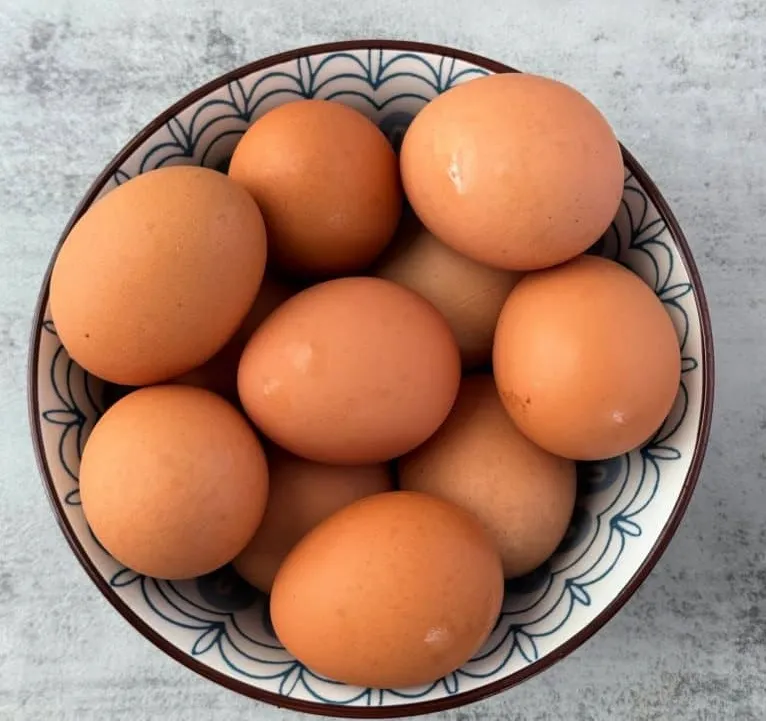
Eggs – I use large eggs, so keep that in mind when I say how much time each time of egg takes to cook. If you use larger or smaller eggs, you will need to adjust the timing.
Oil, Melted Butter or avocado oil spray– to brush the center of the silicone cups before cracking in the eggs.
Pastry Brush, Optional – you can use a paper towel to spread out the oil/butter, but a pastry brush makes it easier.
Silicone Cups
Salt, Pepper, To Season the Eggs
Also Not Pictured: deep skillet or wide pot to cook the eggs.
How to Make Poached Eggs with a Silicone Egg Poacher
Not many ingredients are needed to make poached eggs. Egg poaching is made exceedingly simple when you use an egg poacher cup. The following are the supplies you will require:
First, you will need a large shallow pan. This is my favorite pan, it is a 12″ stone earth nonstick pan. You can find it online here: Stone Pan.
Avocado Cooking Spray. This is the one I like because it doesn’t have any chemicals or propellants added. I get it online here: avocado spray.
And, of course you will need eggs. I always like to use organic pasture raised eggs.
Poached eggs just require a few ingredients. Using an egg poacher cup simplifies the process of poaching eggs considerably.
To see a wide selection of egg poacher cups and pans make sure to check out this post Egg Poacher Cups and Pans for Perfectly Poached Eggs.
How to Poach an Egg in a Silicone Poacher: Making Poached Eggs/Cooking Process
The first step is to add about an inch of water to your pan. Ascertain that there is sufficient water to simmer for the duration necessary to cook the eggs without evaporating.
The egg poaching pan’s water should be able to support the silicone egg poachers so they do not float around.
Elevate your pan to a simmer over medium to high heat on the burner. I just do this to get things going. Lower the heat after the water starts to simmer.
Grab your egg poacher cups and spray them with your avocado oil and place them in the pan.

Crack the eggs into the poached egg cups after that. Try your hardest not to crack the yolk.
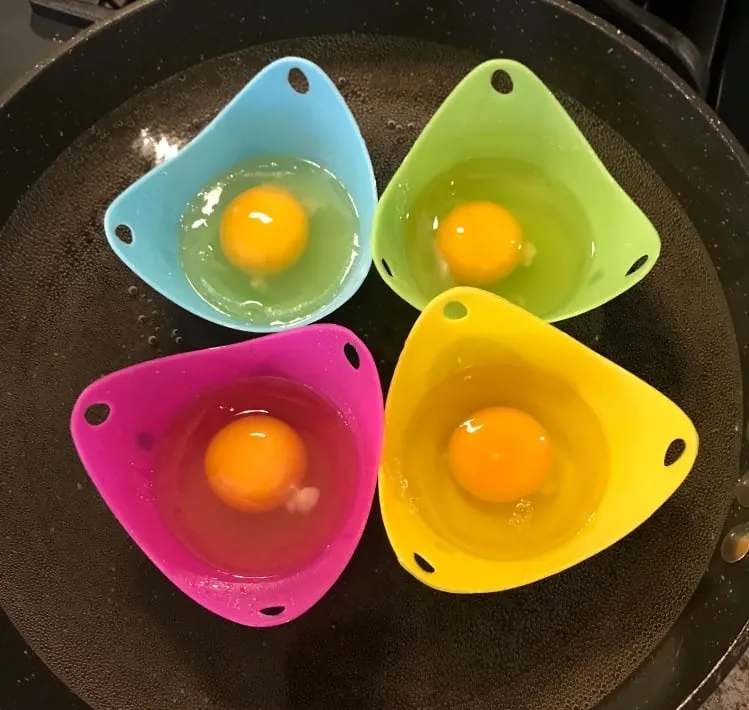
As the simmering water heats you will start to see the eggs slowly cook as the outer edges turn white
Once the water begins to simmer/boil you can lower the heat and cover the pan. My pan does not come with a lid, so I had to buy it separately here (lid).
Using a clear lid always helps, this way you can keep an eye on the eggs while they cook.
How Long To Poach Eggs in Silicone Cups
The duration of cooking for poached eggs is a matter of personal preference. Do you want the yolks of your eggs cooked through or runny? I set a timer as soon as I cover the pan.
I find that 7 minutes is the perfect amount of time to boil the poached eggs in order to maintain the yolks’ runny texture. Your poached eggs should have this runny/poached consistency after seven minutes. Runny yolks are cooked with the egg white portion.
If you prefer your yolks a bit more cooked, like my kids do then I would give it a bit longer. But no more than 10 minutes is necessary. Any more than 10 minutes and you will have something like hard boiled eggs. My kids prefer their yolks like this:

When making poached eggs the timing for how long to poach an egg is really up to you. Once you reach the desired cook time you can turn off the heat. You may have to give it a few tries until you find the perfect poaching time.
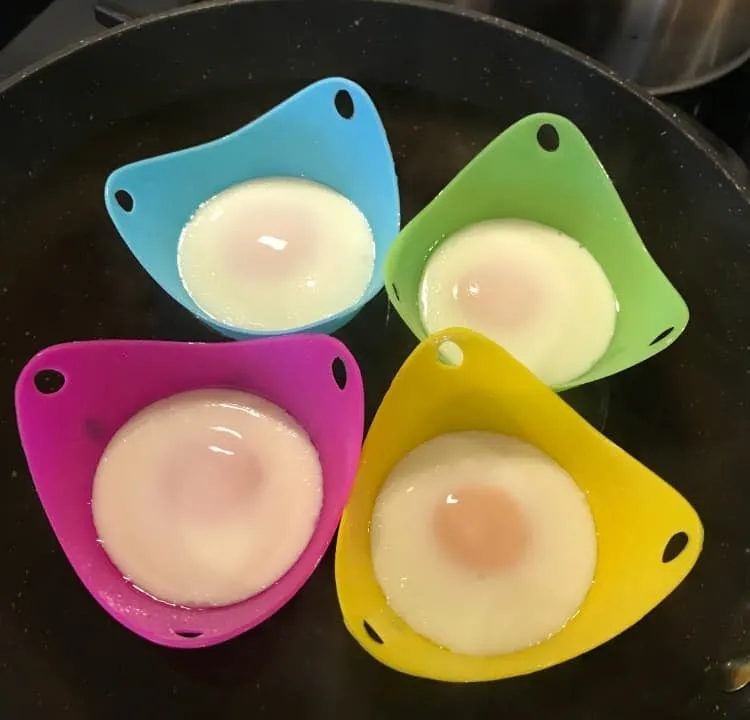
Next, we can remove the silicone egg poacher cups from the water.
Then remove the poached eggs from the silicone egg poachers. The avocado spray helps prevent the eggs from sticking in the poacher cups. To remove them I like to use a spoon, or small spatula, and gently loosen the egg from the cup.
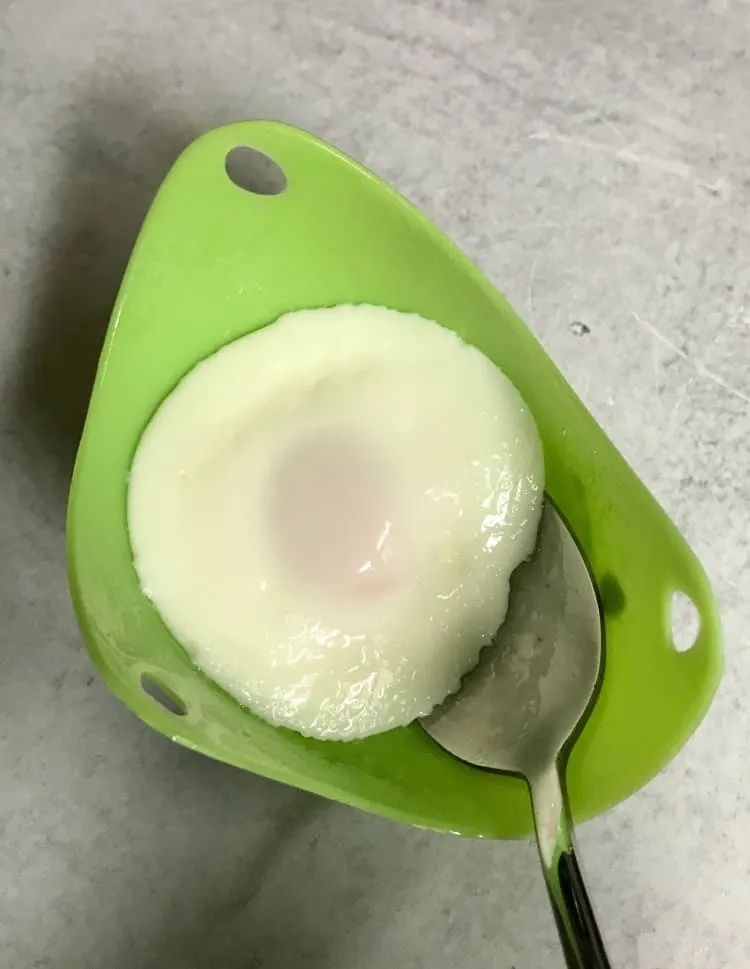
Once the poached egg is loosened from the silicone poacher cups then you can either scoop the poached egg out or flip it right out of the cup itself. If you used a lot of spray oil, you may need to place the poached eggs on a paper towel to drain the excess moisture before plating.
I confess that in our house we refer to these as ‘boobie eggs’.

I truly believe that egg poacher cups are the easiest way to make the best-poached egg. All of your egg is contained in the cup, and none gets lost floating in the water like with the traditional poaching method.
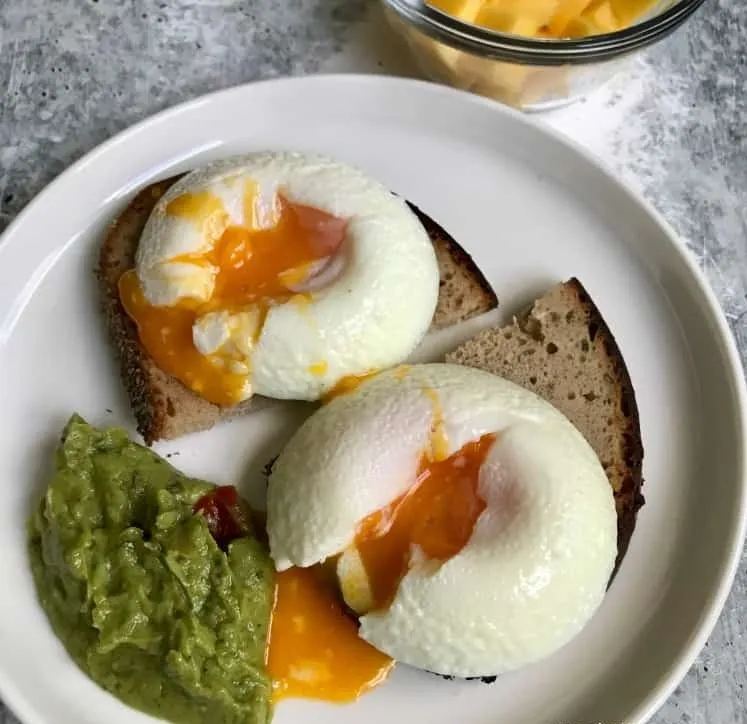
How to Clean the Best Egg Poacher Cups
To clean these silicone poacher cups I usually hand wash with hot soapy water, and then let them air dry before stacking them for easy storage.
What to Eat with Poached Eggs
Poached eggs on toast with avocado or guacamole is our favorite way to eat them.
You can also enjoy your poached eggs on top of sautéed veggies, or leftover air fried vegetables.

If you are super creative or talented in the kitchen you can even use your perfect poached egg to make Eggs Benedict with hollandaise sauce.
As far as poached egg calories, they will hold the number of calories listed on the egg carton. The calories actually vary based on the size of the egg. So if your large eggs are 70 calories each then your poached eggs are 70 calories each. If your jumbo eggs are 80 calories each then your poached eggs are 80 calories each, etc.
Don’t forget to check out these Egg Poacher Cups and Pans for Perfectly Poached Eggs.
Silicone Egg Cooker Recipes
Eggs Benedict: Top half of an English muffin, toasted or untoasted, with a slice of Canadian bacon. Place a poached egg on the ham and drizzle Hollandaise sauce over. Making Hollandaise at home takes some skill, but prepared products are available in the supermarket if you prefer not to make your own.
Shakshuka: Shakshuka is a Jewish breakfast food that originated in Africa. Cook diced onion, garlic and bell pepper in a skillet until soft. Spice with cumin, paprika and cayenne and add canned or fresh, diced tomatoes. Traditionally, eggs are nestled in the pan with the seasoned tomatoes and poached in the sauce, but you can spoon sauce into a bowl and top with an egg poached in a silicone cup.
Hash: Cook peeled and cubed white or sweet potatoes, diced onion and bell pepper in a tablespoon or two of oil until tender-crisp. If the potatoes start to brown before they’re tender, put a lid on the pan for a few minutes to speed the cooking process. Season with salt and pepper and top with a poached egg.
Soup: Top ramen or tomato soup with a poached egg or make a classic Italian poached egg soup by putting a thick slice of toasted bread in a bowl, sprinkling it with Parmigiano-Reggiano cheese and pouring chicken stock over it. Set a poached egg on top.